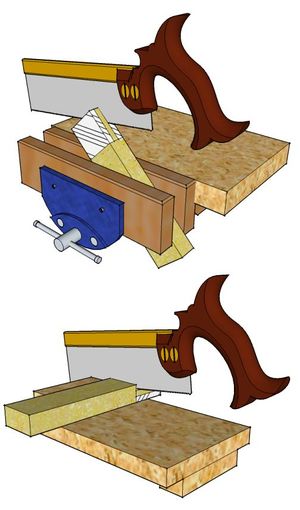Tenon Saw: Difference between revisions
From DT Online
m (Added Template) |
(Added Template) |
||
| (4 intermediate revisions by the same user not shown) | |||
| Line 1: | Line 1: | ||
[[File:CuttingTenons.jpg|300px|right]] | [[File:CuttingTenons.jpg|300px|right]] | ||
__TOC__ | |||
After marking out with try square, mortise gauge and marking knife, the | |||
=====Description===== | |||
[http://en.wikipedia.org/wiki/Backsaw '''Tenon saws'''] are a '''[[Backsaw]]''', typically 250mm or 300mm long, with 10 to 14 teeth per inch ''[[Teeth per Inch|(TPI)]]''. They are used for general woodwork and, in particular, to cut tenons as part of a '''[[Mortise and Tenon Joint]]''', as shown. | |||
=====Features and Applications===== | |||
After marking out with try square, mortise gauge and marking knife, the work-piece is held in a vice such that two lines can be seen and sawn accurately along. Work should be repositioned to ensure that the saw cuts horizontally and the tenon is always on the user's side of the blade - where it can be seen. After cutting two diagonals the work is positioned vertically and the saw completes cutting down the ''‘cheeks’''. | |||
<span style="color: green">'''Note:''' | <span style="color: green">'''Note:''' | ||
Work is positioned such that the saw is pushing down on to the grain fibres and not plucking them up. | Work is positioned such that the saw is pushing down on to the grain fibres and not plucking them up. | ||
Although not common, tenon saws | Although not common, tenon saws were also available with '''[[ripsaw]]''' teeth for this cutting along the [https://en.wikipedia.org/wiki/Wood_grain '''Grain'''] but modern saws are sharpened with universal teeth to cut along and across the grain.</span> | ||
</span> | |||
Tenon ''‘shoulders’'' are first scribed with a marking knife to ensure a clean edge, then cut against a '''[[Bench Hook|bench hook]]''' as shown. The bench hook may be held in a vice - as can the whole work-piece if preferred, instead of a bench hook. | |||
{{Back Saw Buyers Guide}} | |||
[[Category:Secondary]] | |||
[[Category:Cutting Tools]] | |||
Latest revision as of 10:00, 20 August 2016
Description
Tenon saws are a Backsaw, typically 250mm or 300mm long, with 10 to 14 teeth per inch (TPI). They are used for general woodwork and, in particular, to cut tenons as part of a Mortise and Tenon Joint, as shown.
Features and Applications
After marking out with try square, mortise gauge and marking knife, the work-piece is held in a vice such that two lines can be seen and sawn accurately along. Work should be repositioned to ensure that the saw cuts horizontally and the tenon is always on the user's side of the blade - where it can be seen. After cutting two diagonals the work is positioned vertically and the saw completes cutting down the ‘cheeks’.
Note:
Work is positioned such that the saw is pushing down on to the grain fibres and not plucking them up.
Although not common, tenon saws were also available with ripsaw teeth for this cutting along the Grain but modern saws are sharpened with universal teeth to cut along and across the grain.
Tenon ‘shoulders’ are first scribed with a marking knife to ensure a clean edge, then cut against a bench hook as shown. The bench hook may be held in a vice - as can the whole work-piece if preferred, instead of a bench hook.







